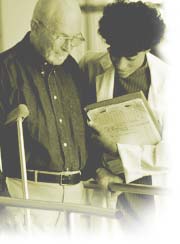
 |
The Prostate Gland Click here to see animated anatomy of Prostate and entire Genito-Urinary System. Click on the below links to get to the desired section of the page. TRANSRECTAL ULTRASOUND (TRUS) GUIDED PROSTATE BIOPSIES Diagnostic Procedure Introduction The most common reason this test is performed is because either a blood test called PSA is abnormally high or the findings on examining the prostate through the back passage are abnormal. PSA stands for prostate specific antigen.It is a substance produced almost exclusively in the prostate and plays a role in fertility.The vast majority is actually released into the ejaculate but tiny amounts are released into the blood stream and can be detected by a simple blood test.Abnormally high levels of PSA can be an indication of disease of the prostate.Common reasons for a high PSA level in the blood stream may include prostate cancer, large prostates, and age related inflammation of the prostate or infection of the prostate. Obviously the first concern is to exclude prostate cancer. The bladder is the organ that stores urine and the urethra is the tube that drains urine out through the penis.The prostate lies immediately beneath the bladder and completely surrounds the urethra and lies immediately in front of the rectum (back passage).Your doctor would have performed on you a Digital Rectal Examination (DRE) (examination via the back passage) of the prostate, an otherwise inaccessible internal organ. Age related enlargement is not a particular concern but if the gland feels abnormally firm or hard, it may sometimes be an indication of an abnormal growth in the prostate gland. Preparation for the test You will have been provided with a prescription for a course of antibiotics. The first tablet should be taken on the morning of the test. The remaining tablets should be taken as directed until completion of the course. Although not critical, but more your own comfort, you should try to open your bowels prior to the procedure. There is no need to fast for the test (that is, you may eat and drink as desired right up until the time of the test). What actually happens? A probe like instrument about 2.5 cm in diameter is gently inserted into the back passage. This is in fact an ultrasound probe that allows visualisation of the prostate beyond what can be felt by the finger alone. More importantly, it allows for the placement of a special biopsy needle that collects samples of your prostate. At the time of biopsy you will hear a loud clicking noise that may startle you momentarily. You will feel a slight sting as the needle passes but it literally happens in a split second. A total of 6 biopsy specimens are usually collected. The procedure takes about 20 minutes and you are able to drive home if you desire but it is often a good idea to have somebody with you due to the natural anxiety you may have over the anticipation of the results. What risks are associated with the procedure? Following a prostate biopsy you can expect to see some blood in the urine, bowel motions and in the semen. Any blood in the urine or bowel motions usually settles by a week although brownish discoloration of the semen can last for up to a month. Uncommonly, you may develop an infection but this risk is minimised by the antibiotics administered. If you develop fevers and begin to shake, which is rare, you should go to the nearest Emergency Department to be assessed. Obtaining results It generally takes up to a week to obtain the results of your biopsy.A copy of the result goes automatically to both your urologist and your referring family doctor.It is critically important that you have a follow up appointment within 7 days of the procedure to follow up on the results of the pathology. |
|||||||
| Dial 000 in an emergency | Home :: Feedback :: Privacy :: Disclaimer | |||||||
Copyright © 2002 Urological Cancer Organisation